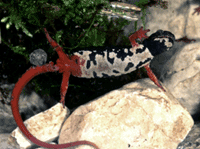Biology, ecology, and genetic structure of Amphibians
People
M.Mattoccia, V.Sbordoni, S.Marta, M.Ciambotta, A.Ventura
Amphibians are well known to be declining dramatically on a global scale. They, in general, are poor dispersers and highly philopatric with strict habitat specificity and physiological requirements. Therefore, Amphibians are proving to be a suitable model for studies of conservation genetics and phylogeography.
Genetic structure of populations and Systematics
Genetic markers can be use successfully in order to resolve intra and interspecific relationships, assess genetic variability, examine the processes of speciation and population diversification. The combined use of mtDNA and nuclear markers indicated the existence of two genetically distinct cryptic species of the Italian spectacled salamanders, Salamandrina perspicillata and S.terdigitata and revealed a hybrid zone between the two lineages. Phylogeographic and historical demographic analyses enabled us to infer the recent evolutionary histories of the two species, and locate their putative refugia in the last glacial period. Microsatellite markers allowed to recognize hybrid individuals, define the extent of the introgression area, and deduce the processes that caused and maintain the hybrid zone.
Conservation and monitoring of endangered species
Information on the genetic structure of amphibians could help to design conservation guidelines for the species most endangered. For Bombina pachypus, a long-term study is being carried out to monitor reproduction in natural populations from the Lepini Mountains. We combine demographic and genetic data to assess genetic variability, dispersal patterns, inbreeding rates and metapopulation structures of the temporary ponds. GIS methods are used to integrate the results and landscape configuration data in order to correlate spatial genetic structure with environmental features.
M. Mattoccia, S. Marta, A. Romano, V. Sbordoni. 2009. Phylogeography of an Italian endemic salamander (genus Salamandrina): glacial refugia, postglacial expansions, and secondary contact. Biological Journal of the Linnean Society, 104: 903–922.
A. Romano, M. Mattoccia, S. Marta, S. Bogaerts, F. Pasmans, V. Sbordoni. 2009. Distribution and morphological characterization of the endemic Italian salamanders Salamandrina perspicillata (Savi, 1821) and S.terdigitata (Bonnaterre, 1789) (Caudata: Salamandridae). Italian Journal of Zoology, 76(4): 422-432.
A.Romano, G.Montinaro, M.Mattoccia, V.Sbordoni. 2007. Amphibians of the Aurunci Mountains (Latium, Central Italy). Checklist and conservation guidelines. Acta Herpetological 2 (1):17-25.
M.Mattoccia, B.Cari, A.Romano e C.Angelini. 2006 Osservazioni sull’ecologia di alcune popolazioni di Bombina pachypus (Amphibia: Bombinatoridae) nei Monti Lepini (Lazio) 2006. Zuffi M.A.L. (Ed.) Atti V Congresso Nazionale Societas Herpetologica Italica, Calci (PI), 29 sett.- 3 ott. 2004. Firenze University Press, 161-166.
M.Mattoccia, A. Romano and V.Sbordoni. 2005. Mitochondrial DNA sequence analysis of the spectacled salamander, Salamandrina terdigitata (Urodela: Salamandridae), supports the existence of two distinct species. Zootaxa, 995:1-19.
A.Romano M.Mattoccia. Maximum size of Spectacled salamander Salamandrina perspicillata (Savi, 1821). 2005. Herpetozoa 18 (3/4) :186-187.
C.Angelini, B.Cari, M.Mattoccia e A.Romano.2004. Distribuzione di Bombina variegata pachypus (Bonaparte, 1838) sui Monti Lepini (Lazio) (Amphibia: Anura). Atti Soc. it. Nat. Museo civ. Stor. Nat. Milano, 145 (II):321-328.
 Salamandrina perspicillata
Salamandrina perspicillata